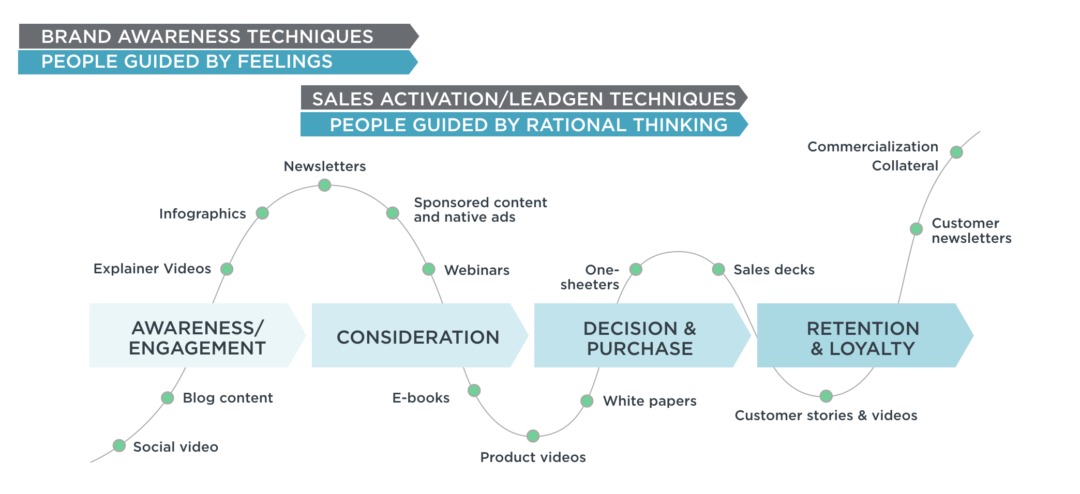Content Marketing
How a Common Content Strategy Unites Marketing’s Different Natures
I recently wrote about the many natures of marketing, including brand awareness and short-term sales activation (or lead gen, as we B2B marketers call it) and the role of content within an overall marketing strategy.
The latest seminal research from Les Binet and Peter Field, titled Effectiveness in Context, analyzes hundreds of campaigns from the IPA Databank (with a focus on marketing effectiveness) and clarifies the dual model. I want to focus on the role of content strategy within an overarching marketing strategy, and how content will contribute to a common alignment across the different natures of marketing.
The last few years have seen short-term sales activation become the first priority of most enterprises, especially in the B2B domain. Enterprises invest most of their money into short-term, bottom funnel campaigns driven mostly by online paid media programs and related content, in the hope that they’ll lift sales for the next few quarters. I had a similar priority when I led marketing for a division of a large enterprise in the energy industry—brand was simply a minor focus. I keep seeing this appear as a common practice in many of the enterprises I advise. Short-term activation campaigns and sales programs were successful in most of the cases. At least, this is what I—and most marketers—thought.
According to Binet and Field, marketing effectiveness is in decline and “short-termism” is, in many ways, the mother of all marketing problems. What exactly happened? As I have mentioned, marketers have become increasingly short-term in their focus. They spend money on immediate sales activation rather than longer-term brand building. But in one of the most important sections of their research, the two authors demonstrate that over the longer term, this short-termism will rapidly deteriorate the overall impact of marketing.
Too much time spent picking the low-hanging fruit means less time watering the tree. Eventually the tree stops growing.
In most cases, a solid and documented content strategy was not even requested nor was it ever put in place. You don’t need a content strategy for executing short-term sales activation campaigns.
But things are changing—marketers are beginning to adopt an integrated model. “Brand communications create enduring memory structures that increase the base level of demand and reduce price sensitivity,” Binet said in the report. “Sales activation triggers these memories and converts them efficiently into immediate sales.”
Brand building and sales activation are not choices or alternatives—they are mutually interdependent and both are essential to long-term success. Sales activation marketing is best served by tight targeting and relevant messages, and it should focus on building your customer’s physical, tangible understanding of your brand. In contrast, brand awareness building is about increasing a consumer’s internal conception of your brand, and it is primarily driven by content that expands audience reach through stories, educational and informational content, inciting emotions, and making associations.
I have seen this play out with the clients I consult and work with, which are mostly large enterprises in the sectors of tech, finance, and energy. While in the past my strategy workshops were mostly attended by brand and content leaders, I’ve found that my audience has expanded to a vastly diverse crowd of marketers from many different domains: performance marketing, paid media, social media, and PR teams. They all share a primary challenge: securing alignment across a common audience and buyer journey.
I’ve found that this audience of professional communicators also shares the following across their different industries:
- Business and marketing goals – Marketers may pursue different micro-goals (eg. brand lift or number of leads), but they always share common macro-goals
- Common audience – They’re targeting the same people, but their approach targets different phases of the buyer journey. Brand and content focus mostly on awareness, and performance marketing targets consideration, decision, and inspiring purchases.
- Common buyer journey – Again, marketers target different stages and they clearly have different needs. Marketers focusing on brand/content need to design a centralized audience-centric content strategy. Performance marketers need to understand what resonates with their audience in the decision/purchase phases of the journey, and use good content for their activation campaigns. Field marketers need sales enablement content which spans across different stages. Social media & comm marketers need to secure alignment with the previous functions in order to lend support with solid content distribution.
- Common strategy – Built around audience and buyer journey, top funnel content and storytelling will fuel brand awareness and build enduring memories. Medium and bottom funnel content will feed the immediate need for sales activation programs.
Overall, the role of content marketing is evolving. What was once an individual and isolated rebel approach when Joe Pulizzi wrote his first books is now a consolidated mainstream role within the overarching marketing strategy.
Get better at your job right now.
Read our monthly newsletter to master content marketing. It’s made for marketers, creators, and everyone in between.






